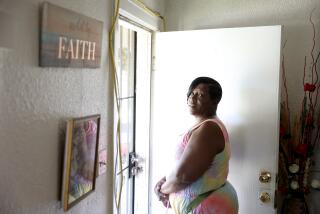L.A. County foster care shortage reaches crisis level
- Share via
Los Angeles County’s shortage of foster care beds has reached a crisis point, with state officials threatening to impose fines because too many children are languishing in sometimes chaotic holding rooms during traumatic separations from their families.
Officials say the problem intensified in recent weeks after the widely publicized torture death of 8-year-old Gabriel Fernandez, for which his mother and her boyfriend have been charged. The Palmdale boy’s case triggered a jump in child abuse hotline calls and the number of children entering county protective care.
Between May 28 and July 5, nearly 600 children were diverted to holding rooms as social workers scrambled unsuccessfully to find them homes, according to data obtained under the California Public Records Act.
Stays exceeded a state-imposed 24-hour legal limit in 117 cases, and dozens of children spent multiple nights in the holding centers before being placed in foster homes. By comparison, last August only one child remained in a holding room longer than 24 hours, and overall about a third fewer children were diverted to the centers.
Typically, children who become stuck in the government-run way stations are the hardest to place: infants, largegroups of siblings, children returning from failed placements and the mentally ill or those afflicted with lice, ringworm, chickenpox, respiratory problems and other infectious diseases. Placing a child often requires more than 100 calls by social workers, records showed.
California regulators have given the county until Wednesday to fix the problem or face possible daily financial penalties.
And a prominent nonprofit law firm is warning it may bring legal action to force a resolution of the problems it says state and county officials have failed to address in the past.
The San Francisco-based Youth Law Center maintains that potential state penalties of $200 a day have been ineffective and don’t apply to a serious shortcoming of the system: instances in which children have multiple holding room stays of less than 24 hours because they are shuffled between child welfare facilities.
“This crisis has been building for several years,” said Maria Ramiu, a Youth Law Center lawyer. “The state just hasn’t been able to fix the problem.”
Children younger than 12 typically go to the Children’s Welcome Center on the campus of the Los Angeles County-USC Medical Center. A large open space with cribs for infants and cots for other children, it can have as many as 29 children sleeping over on some nights.
Officials acknowledged they don’t always have enough personnel to promptly feed children or change diapers. The department recently issued an emergency plea for community volunteers to help in the holding rooms.
Older children who can’t be quickly placed in foster homes typically are sent to a conference room in a high-rise building south of downtown Los Angeles, where they sleep on the floor or cots, according to social workers staffing the facility.
Employees have told The Times a volatile mix involving teenagers can land in the facility. At times, objects have been thrown and police have been called to restore order, said Lincoln Saul, a recently retired county social worker who worked at the center.
In addition to lingering in holding centers, hard-to-place children often endure a bureaucratic gantlet, records and interviews show. Each day, social workers take them to various regional offices across the county as the search for foster homes continues.
If nothing is found, they are driven back to the holding rooms in the evening. During the placement hunt, they are not enrolled in school, have no rooms of their own and have virtually no privacy.
“I wouldn’t say this problem is under control, but we are making progress,” said Philip Browning, director of the Department of Children and Family Services.
A number of factors has exacerbated the foster bed shortage. For one, the county lacks an accurate, real-time database of foster home vacancies. The system, updated just once a month, lists the licensed capacity of a home but not the number of beds a foster parent now is willing to fill.
Social workers are left largely to their own contacts, experience and word of mouth to find vacancies. Records show offices with more experienced workers, such as the West San Fernando Valley, rarely use holding rooms. Offices with some of the newest social workers — in Hawthorne, Compton, South Los Angeles and Palmdale — resort to holding rooms more frequently.
Efforts to improve tracking of vacancies are under way, Browning said. But he added that it would not compensate for the fundamental problem: too few foster homes.
Over the last decade, the number of foster parents has been declining faster than a reduction in children entering the foster system. In 2007, the county had 7,800 children in 6,380 foster family homes; there now are 6,300 children in 3,440 foster homes.
The bed shortage is especially acute for infants, partly because the gap between the cost of caring for the children and what the state pays families is the greatest. California’s reimbursement rate for very young children would have to be increased 61% to match foster parents’ costs, according to a recent study by Children’s Rights, a national foster care advocacy group.
The rate for children younger than 4 was recently boosted to about $680 a month, which is still hundreds of dollars below the estimated costs for foster parents.
“We need more homes and we need to pay them more,” Browning said. “But the rates are set by the state, not the county, and that constrains us.” The department is exploring ways to ease the financial burden of young children, such as providing free child care, diapers and transportation.
Browning said the county is entering new contracts with private, nonprofit foster care agencies to accept children 24 hours a day. Officials also recently agreed to pay the county’s probation department $400,000 to speed up criminal background checks on relatives who are willing to take children removed from homes.
Astrid Heger, a doctor who leads a medical assessment team for foster children in the County-USC Medical Center holding center, criticized the response to the crisis by state agencies that fund and regulate the system.
There is one advantage to children passing through holding rooms, she said. With her program on site, for example, the USC center provides a venue for formal medical and mental health assessments of young children, which help ensure placements are appropriate and reduce return visits, she said. But her team isn’t always given the time to fully assess foster children, particularly in complex cases that require extra resources, she said.
“I’m completely fed up with success being ... we got the kid out of here within 24 hours,” Heger said. “There is a lot more that needs our attention.
“How can you plan for these kids when you don’t know what’s really wrong with them?”
More to Read
Sign up for Essential California
The most important California stories and recommendations in your inbox every morning.
You may occasionally receive promotional content from the Los Angeles Times.











